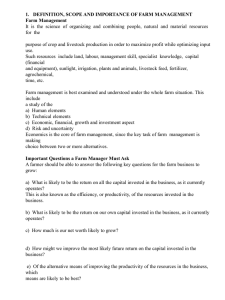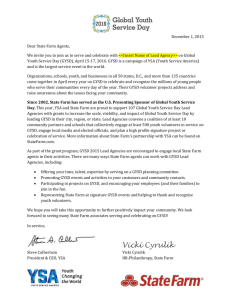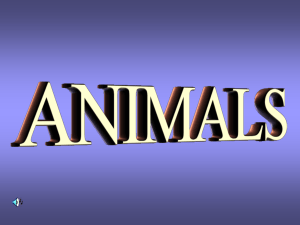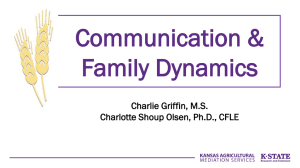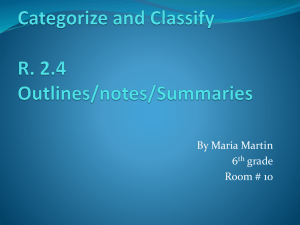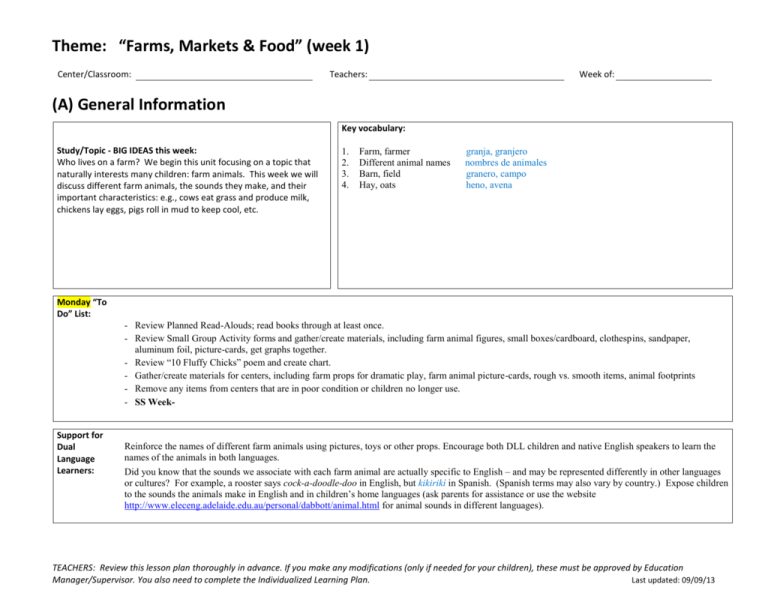
Theme: “Farms, Markets & Food” (week 1)
Center/Classroom:
Teachers:
Week of:
(A) General Information
Key vocabulary:
Study/Topic - BIG IDEAS this week:
Who lives on a farm? We begin this unit focusing on a topic that
naturally interests many children: farm animals. This week we will
discuss different farm animals, the sounds they make, and their
important characteristics: e.g., cows eat grass and produce milk,
chickens lay eggs, pigs roll in mud to keep cool, etc.
1.
2.
3.
4.
Farm, farmer
Different animal names
Barn, field
Hay, oats
granja, granjero
nombres de animales
granero, campo
heno, avena
Monday “To
Do” List:
- Review Planned Read-Alouds; read books through at least once.
- Review Small Group Activity forms and gather/create materials, including farm animal figures, small boxes/cardboard, clothespins, sandpaper,
aluminum foil, picture-cards, get graphs together.
- Review “10 Fluffy Chicks” poem and create chart.
- Gather/create materials for centers, including farm props for dramatic play, farm animal picture-cards, rough vs. smooth items, animal footprints
- Remove any items from centers that are in poor condition or children no longer use.
- SS WeekSupport for
Dual
Language
Learners:
Reinforce the names of different farm animals using pictures, toys or other props. Encourage both DLL children and native English speakers to learn the
names of the animals in both languages.
Did you know that the sounds we associate with each farm animal are actually specific to English – and may be represented differently in other languages
or cultures? For example, a rooster says cock-a-doodle-doo in English, but kikirikí in Spanish. (Spanish terms may also vary by country.) Expose children
to the sounds the animals make in English and in children’s home languages (ask parents for assistance or use the website
http://www.eleceng.adelaide.edu.au/personal/dabbott/animal.html for animal sounds in different languages).
TEACHERS: Review this lesson plan thoroughly in advance. If you make any modifications (only if needed for your children), these must be approved by Education
Manager/Supervisor. You also need to complete the Individualized Learning Plan.
Last updated: 09/09/13
Family/
Community
Involvement:
Ask families who speak other languages at home, or come from different countries, to tell you what animals “say” in their language. Invite parents to teach
the class different sounds for Old McDonald, or provide the animal sounds for a read-aloud.
Keep families updated about the activities you are doing in the classroom, and the vocabulary you are using. For example, you could post a question or
clue on the door for parents to see at pick-up time: “Today we read about an animal that said oink … but it wasn’t a pig! Ask your child to tell you about
it!” Change the note daily to reflect the read-aloud, discussions or other activities from that day.
There are always props and materials needed for classroom activities, and parents can be extremely helpful by donating or lending items. This week items
include clothespins, strips of cardboard, and small boxes (e.g., clean milk cartons, shoe boxes, etc.).
If possible, arrange for a trip to a nearby farm or farmer’s market.
(B) Materials to Enhance Children’s Play
Blocks
Dramatic Play
Add:
“Clothespin Fences” – small boxes or strips of
cardboard; clothespins (wooden if possible)
Farm animal figures
Add:
Rake, shovel, hoe
Baskets, plastic vegetables and fruit
Farmer’s hat
Plastic eggs (white or different colors to sort), egg
cartons(clean)
Stuffed animals (types that would live on a farm)
Art
Toys and Games
Add:
“Smooth vs. Rough” – various items for children to
sort into two containers (labeled with word and
example of that kind of material)
Farm Animal sort – assorted pictures of animals (see
Activities packet for examples); encourage children
to sort by farm vs. non-farm animals or by other
characteristic (e.g., number of legs)
Library/Writing
Keep any items from previous week(s) that children
were particularly engaged with.
Add:
Sandpaper of different coarseness; pencils and paper
Add:
Read-aloud books for this week
Other books about farms or animals (if available)
Pictures (laminated, on word cards or felt) of
different animals. See Activities packet.
Sand and Water
Discovery/Science
Add:
Animal hair/ wool if available and magnifying glass
Sand paper and pieces of wood to sand
Music and Movement
Add:
Farm animals and soapy water in a “tub” to wash them
Variation: Put soapy water in a tub inside water table; in
the extra space, provide washable markers/paint, or a bin
of dirt, so children can get animals dirty and then clean.
Add:
Song charts for familiar farm-related or animalrelated songs (Old MacDonald, Ten Fluffy Chicks,
High-Ho the Derry-oh, etc...)
Outdoors
Computers
Add:
Cooking
Add:
Sticks to act as horses
Balance beams
© 2012 Acelero, Inc. All Rights Reserved. Uses are subject to the limitations set forth in your user agreement. Your right to use these materials is contingent upon remaining a current
SARGE subscriber with Acelero, Inc.
“Animal Footprints.” Cut footprints out of different-colored construction paper representing different animals
(e.g. horse, dog, chicken). Place footprints around outdoor area and encourage children to follow them. Give
children directions – “go to a blue horse footprint, then a red dog footprint” – or allow them to direct you.
(C) Group Experiences
Monday
Arrival
Opening
Circle
Movement
Relaxation
Transitions
Closing
Circle
Tuesday
Arrival: Attendance graph
Morning Circle:
-Welcome song & one
other
-SS Puppet Script
-Introduce theme (we will
be learning about farms and
farm animals!), building off
QOTD by talking further
about these animals, what
children know about them
and where we might see
them.
Review daily schedule and
rules now and throughout
the day
Transition: Question of the
Day (QOTD): Which do
you like best? (cows/
chickens/ horses) Provide
visuals of each answer
choice. Have children
answer during arrival or
transition, charting with
whiteboard/pocket chart/etc
Music/Movement: SS Song
& one other
Wednesday
Thursday
Friday
Arrival: Attendance graph
Arrival: Attendance graph
Arrival: Attendance graph
Morning Circle:
-Welcome song & one
other
Morning Circle:
-Welcome song & one
other
Morning Circle:
-Welcome song & one
other
- Discussion: What do we
already know about farms?
Have props available to
spur children’s thinking –
e.g., animal figurines, barn
toy or photo, etc. Use KWL
format or have more openended discussion. See KWL
Chart Guidelines.
- Animal Sounds: Briefly
describe different animals
and have children guess
what they are. Have them
help you make the animal
sounds. Allow children to
give clues about different
animals. Include the
appropriate animal sounds
from children’s home
languages.
- QOTD: Do you have an a
in your name? (Have name
cards nearby and encourage
children to count how many
a’s they have)
Review daily schedule and
rules now and throughout
the day
Transition: farm animal vs.
forest/ocean/jungle etc.
sorting activity
Music/Movement: :
“Animal March” (see
below) & one other
Relaxation:
Transition: Which animal
sound do you think is the
loudest? (moo/oink)
Review daily schedule and
rules now and throughout
the day
Transition: SS Brain
Builder-
Music/Movement: SS Song
& “Old MacDonald Had a
Farm”
Relaxation:
Review daily schedule and
rules now and throughout
the day
Transition: How Many Legs
are there? Graph, refer to
page 68 in High Five
Mathematize
Music/Movement: : “Old
MacDonald Had a Farm” &
one other
Relaxation:
Transition: SS Skill ActivityClosing Circle:
Goodbye song
Transition:
© 2012 Acelero, Inc. All Rights Reserved. Uses are subject to the limitations set forth in your user agreement. Your right to use these materials is contingent upon remaining a current
SARGE subscriber with Acelero, Inc.
Monday
Tuesday
Wednesday
Thursday
Closing Circle:
Goodbye song
Closing Circle:
Goodbye song
Group 1: The Cow That
Went Oink by Bernard Most
(basic comprehension of
story problem/resolution;
noticing things about farms)
Group 1: Mrs. Wishy
Washy’s Farm by Joy
Cowley
Group 1: SS Story and
Discussion-
Group 2: Mrs. Wishy
Washy’s Farm by Joy
Cowley
(build on understanding of
farms/animals, reality vs.
fiction )
Group 2: The Cow That
Went Oink by Bernard Most
Group 1: – Farm Animals
(building fences and
sorting)
Group 1: Silly Words &
Animals or Find the Rhyme
(see activity guides)
Group 2: Silly Words &
Animals or Find the Rhyme
(see activity guides)
Group 2: – Farm Animals
(building fences and
sorting)
Relaxation:
Friday
Transition: SS Brain
BuilderClosing Circle:
Review QOTD results with
the full group, counting
each column and writing
the numeral.
Goodbye song
ReadAlouds
SmallGroup
Activity
Special
Activities
Tangible
Acknowledgement System:
Group 1: SS bookGroup 2: SS Story and
Discussion-
Group 2: SS book-
Group 1:SS Skill ActivityGroup 2: – Rough vs.
Smooth (writing with
sandpaper/aluminum foil)
see activity guide
Group 1: – Rough vs.
Smooth (writing with
sandpaper/aluminum foil)
see activity guide
Group 2: SS Skill Activity-
Use animal sounds as the
“beat” for children to march
© 2012 Acelero, Inc. All Rights Reserved. Uses are subject to the limitations set forth in your user agreement. Your right to use these materials is contingent upon remaining a current
SARGE subscriber with Acelero, Inc.
Monday
Tuesday
Wednesday
Thursday
Friday
to, e.g.: Moo, moo, moo or
Oink, 2, 3, 4. Vary by
changing the pace or using
sound-words to cue
different types of movement
(“When I say neigh, run in
place!”)
Outside
Inclement Weather Plan:
© 2012 Acelero, Inc. All Rights Reserved. Uses are subject to the limitations set forth in your user agreement. Your right to use these materials is contingent upon remaining a current
SARGE subscriber with Acelero, Inc.
Individual Child Planning Form
School Readiness Goal
Focus Domain(s)
Physical
Approaches to
Learning
Language &
Literacy
Cogn./ Gen.
Knowledge
Name
Soc-Emotional
Focus
Date
Child’s
Week of:
Strategy/Activity
Focus TS
GOLD
Objective(s)
Why Chosen?
(IFSP, TS Gold Report,
family input, conference
goal, etc.)
NOTE: Children with similar needs may benefit from
differentiated instruction (e.g. during small-group activity).
You can use the “Small Group” column at right to make notes
about possible groupings.
Example: 1. Routine – activity, state how you are
individualizing for this child.
CHECK when
implemented
Teachers:
Possible small-group?
Center/Classroom:
1.
2.
3.
1.
2.
3.
1.
2.
3.
1.
2.
3.
1.
© 2012 Acelero, Inc. All Rights Reserved. Uses are subject to the limitations set forth in your user agreement. Your right to use these materials is contingent upon remaining a current
SARGE subscriber with Acelero, Inc.
2.
3.
1.
2.
3.
1.
2.
3.
IFSP Child Planning
Child’s Name
IFSP Goals
Classroom Plan: What’s the Activity/Who’s Supporting the Child
*Please review all IFSP plans including Speech Only to ensure implementation of all classroom goals.
*For speech goals the what/who would be: Directed by the Speech Language Therapist
© 2012 Acelero, Inc. All Rights Reserved. Uses are subject to the limitations set forth in your user agreement. Your right to use these materials is contingent upon remaining a current
SARGE subscriber with Acelero, Inc.


